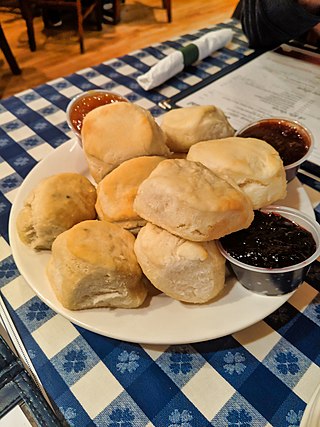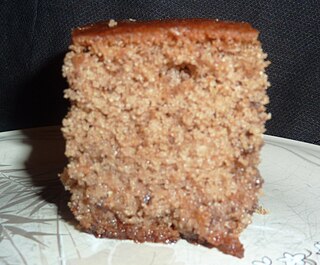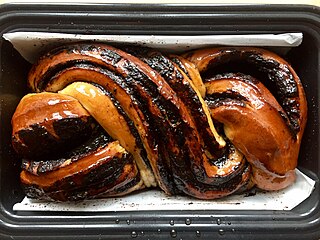
Pita or pitta is a family of yeast-leavened round flatbreads baked from wheat flour, common in the Mediterranean, Levant, and neighboring areas. It includes the widely known version with an interior pocket, also known as Arabic bread. In the United Kingdom, Greek bread is used for pocket versions such as the Greek pita, and are used for barbecues as a souvlaki wrap. The Western name pita may sometimes be used to refer to various other types of flatbreads that have different names in their local languages, such as numerous styles of Arab khubz (bread).

Tahini or tahina is a Levantine condiment made from toasted ground sesame. Its more commonly eaten variety comes from hulled sesame, but unhulled seeds can also be used for preparing it. The latter variety has been described as slightly bitter, but more nutritious. It is served by itself or as a major ingredient in hummus, baba ghanoush, and halva.

A bakery is an establishment that produces and sells flour-based baked goods made in an oven such as bread, cookies, cakes, doughnuts, bagels, pastries, and pies. Some retail bakeries are also categorized as cafés, serving coffee and tea to customers who wish to consume the baked goods on the premises. In some countries, a distinction is made between bakeries, which primarily sell breads, and pâtisseries, which primarily sell sweet baked goods.

An Eccles cake is a small, round pie, similar to a turnover, filled with currants and made from flaky pastry with butter, sometimes topped with demerara sugar.

Kuchen, the German word for cake, is used in other languages as the name for several different types of savory or sweet desserts, pastries, and gateaux. Most Kuchen have eggs, flour and sugar as common ingredients while also, but not always, including some fat. In the Germanosphere it is a common tradition to invite friends over to one's house or to a cafe between noon and evening to drink coffee and eat Kuchen.

Bulgarian cuisine is part of the cuisine of Southeast Europe, sharing characteristics with other Balkan cuisines. Bulgarian cooking traditions are diverse because of geographical factors such as climatic conditions suitable for a variety of vegetables, herbs, and fruit. Aside from the variety of local Bulgarian dishes, Bulgarian cuisine shares a number of dishes with its neighboring countries, in particular with Turkish and Greek cuisine.

Iraqi cuisine is a Middle Eastern cuisine that has its origins in the ancient Near East culture of the fertile crescent. Tablets found in ancient ruins in Iraq show recipes prepared in the temples during religious festivals—the first cookbooks in the world. Ancient Mesopotamia was home to a sophisticated and highly advanced civilization, in all fields of knowledge, including the culinary arts.

Levantine cuisine is the traditional cuisine of the Levant, in the sense of the rough area of former Ottoman Syria. The cuisine has similarities with Egyptian cuisine, North African cuisine and Ottoman cuisine. It is particularly known for its meze spreads of hot and cold dishes, most notably among them ful medames, hummus, tabbouleh and baba ghanoush, accompanied by bread.

Cozonac or Kozunak is a sweet yeast dough that can be used to make different traditional holiday breads and cakes. Often mixed with raisins, it can be baked as a loaf or rolled out with fillings like poppy seed or walnuts. It is common throughout Southeastern Europe in countries such as Romania, Moldova, Bulgaria, Serbia, North Macedonia and Greece. Rich in eggs, milk and butter, it is usually prepared for Easter in Romania, Serbia, Bulgaria, and in Romania and Moldova it is also traditional for Good Friday. The name comes from the Bulgarian word for hair-коса/kosa, or Greek: κοσωνάκι, romanized: kosōnáki, a diminutive form of κοσώνα, kosṓna.

Israeli cuisine primarily comprises dishes brought from the Jewish diaspora, and has more recently been defined by the development of a notable fusion cuisine characterized by the mixing of Jewish cuisine and Arab cuisine. It also blends together the culinary traditions of the various diaspora groups, namely those of Middle Eastern Jews with roots in Southwest Asia and North Africa, Sephardi Jews from Iberia, and Ashkenazi Jews from Central and Eastern Europe.

In the United States and Canada, a biscuit is a variety of baked bread with a firm, dry exterior and a soft, crumbly interior. It is made with baking powder as a leavening agent rather than yeast, and at times is called a baking powder biscuit to differentiate it from other types. Like other forms of bread, a biscuit is often served with butter or other condiments, flavored with other ingredients, or combined with other types of food to make sandwiches or other dishes.

A tahini roll or tahini bread roll is a sweet pastry found commonly in the cuisines of Arab countries, Armenia, Cyprus, Greece and Turkey. Tahini roll originated in Armenia, where they are called tahinov hatz.

Karydopita is a Greek dessert cake made primarily from walnuts and covered in a sweet syrup. Its name is a compound word which derives from "karýdia" and "pita".

A babka is a sweet braided bread which originated in the Jewish communities of Poland and Ukraine. It is popular in Israel and in the Jewish diaspora. It is prepared with a yeast-leavened dough that is rolled out and spread with a filling such as chocolate, cinnamon, fruit, or cheese, then rolled up and braided before baking.














